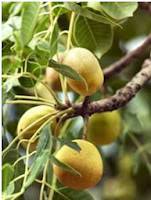 The marula is a fairly attractive deciduous tree that grows to a
medium-size of around 7-18m. It has a broad, mostly straight trunk and a
widely spreading, fairly dense, rounded crown. Old stems are fairly
smooth and the bark peels off sporadically in rather large, flat,
roundish discs exposing underlying yellowy bark. This in turn colours
the old stems grey with yellowish patches.Leaves on the marula are compound with 3-7 pairs of leaflets and a
terminal one 30-100 x 15-40mm. On young plants the leaves have toothed
margins. The small flowers are pinkish-red in colour, and male and
female flowers occur on separate trees and bloom September-November. The
fruits are large and fleshy, up to 40mm in diameter and ripen yellow in
January-March.
The marula is a fairly attractive deciduous tree that grows to a
medium-size of around 7-18m. It has a broad, mostly straight trunk and a
widely spreading, fairly dense, rounded crown. Old stems are fairly
smooth and the bark peels off sporadically in rather large, flat,
roundish discs exposing underlying yellowy bark. This in turn colours
the old stems grey with yellowish patches.Leaves on the marula are compound with 3-7 pairs of leaflets and a
terminal one 30-100 x 15-40mm. On young plants the leaves have toothed
margins. The small flowers are pinkish-red in colour, and male and
female flowers occur on separate trees and bloom September-November. The
fruits are large and fleshy, up to 40mm in diameter and ripen yellow in
January-March.The marula is a very busy tree indeed. The leaves are browsed by game and the bark is stripped by elephants. The fruits are edible and exceptionally high in vitamin C content and are eaten by livestock, game, monkeys, baboons and humans. They are used to brew an alcoholic drink and they make a delicious jelly preserve. The tasty nut-like kernels are also eaten by humans. The bark is used in traditional medicine and butterflies and moths breed on the tree. The timber is used for carving and firewood and the bark can be used to make a dye. Marula grows in a woodland habitat and can be found in the far north of Namibia.
Some Lodges where this tree may be found:
Ondangwa Hotel, Oshakati Country Lodge, Ruacana Eha Lodge.
For generations, women in the Oshana, Ohangwena, Omusati and Oshikoto regions of north-central Namibia have been using it as a source of food as well as for its cosmetic properties. Inside the fruit is a large nut, which reveals two to four locules. When broken open, each contains an oil-rich kernel. With a skill handed down from generation to generation, rural women are able to remove these small kernels and squeeze out the oil. This they then use either as an ingredient to complement the taste and texture of traditional chicken and mahango dishes, or as a moisturiser on their skin.






No comments:
Post a Comment